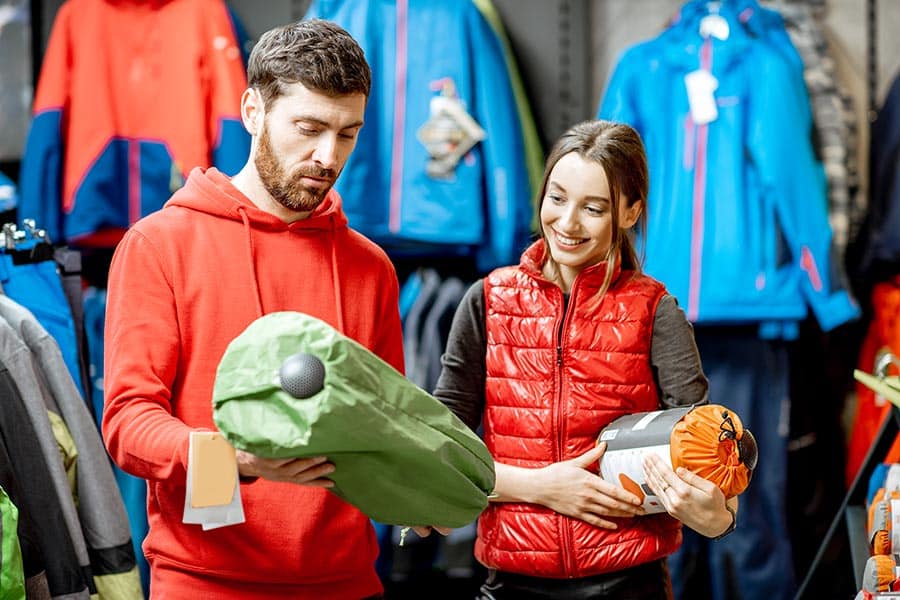
Are you looking for a sleeping bag to use while camping? With so many different types, sizes, and materials on the market, it can be overwhelming trying to choose the right one. But don’t worry – we’re here to help. In this blog post, we’ll break down the factors you need to consider when choosing a sleeping bag for camping so that you can select the perfect one for your needs.
When choosing the right sleeping bag for camping, key features to consider are temperature rating, shell material, insulation type, shape and size, additional features, your budget, and ease of care and maintenance.
Choosing the right sleeping bag for camping is an important decision. It affects how comfortable and safe you are during your trip – not just in terms of temperature but also from potential hazards like insects or other animals. Plus, a quality sleeping bag can make all the difference in how fun and memorable your camping experience is. So it’s worth taking the time to find the best one for you.
Several key factors must be considered when selecting a sleeping bag for camping. First and foremost, look at the bag’s temperature rating – you want to ensure it suits the climate you will be camping in. It’s also important to consider how much insulation the bag provides, as well as size and weight – this will determine if it’s easy to transport while on your journey.
Additionally, consider any additional features, such as hoods or cinch straps, that may be useful during your trip. Finally, pay attention to the construction material and ensure it meets any relevant regulations or standards for safety.
Temperature Rating
When selecting a sleeping bag, it’s essential to consider the temperature rating. This number indicates the lowest temperature at which the bag can provide sufficient insulation for comfort. For example, a sleeping bag with a 30°F temperature rating should keep you warm in temperatures down to 30°F.
It’s important to note that this is just an estimate – it tends to be conservative and should not be used as an exact guide for how cold it will get during your camping trip. However, it’s still wise to bring extra layers of clothing or other insulation (like sleeping pads) if you plan on spending time outdoors in lower temperatures.
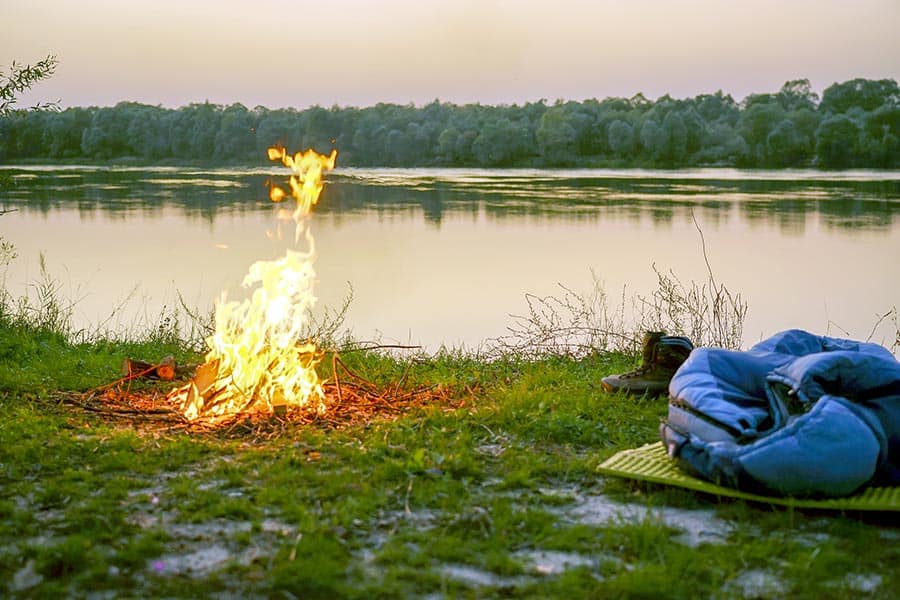
Ultimately, choosing the right sleeping bag temperature rating depends on where and when you plan on camping, so make sure you do your research before making any decisions. Sleeping bags have different temperature ratings based on the type of insulation they offer. The most common are the season, comfort, and extreme ratings.
Season Rating: This is the most basic level of insulation and generally provides enough warmth for summer camping trips in mild temperatures (above freezing). It’s best suited for car campers who may not need extreme temperatures or weight restrictions.
Comfort Rating: A comfort rated sleeping bag is usually recommended for mild to cool climates with winter conditions. It typically offers additional insulation and a greater range of temperatures than the season rating.
Extreme Rating: An extreme rated sleeping bag is necessary for intense cold climates and high altitudes as it provides superior warmth and protection from cold temperatures. These bags are designed to keep you comfortable even in sub-zero conditions.
Certain temperature ratings may be more appropriate than others depending on where you plan to camp and what time of year it is. Research the climate and make sure you choose a sleeping bag that fits your needs so you can stay safe and warm during your trip.
Tips for selecting a sleeping bag with the right temperature rating
When selecting a sleeping bag, it’s important to consider the temperature rating. Here are some tips to ensure you get the right one for your needs:
- Research the climate of where you plan on camping and what time of year it is so that you can choose an appropriate temperature rating.
- If you plan on camping in a wide range of temperatures, opt for a bag with a comfort or extreme rating.
- Consider your overall weight allotment when choosing a sleeping bag, as heavier bags tend to offer more insulation and warmth.
- Take into account any special needs like allergies or medical conditions that may affect your choice.
- Check other campers’ reviews to ensure the sleeping bag is reliable and well-made.

Shell Material
Sleeping bag shells are typically made of polyester, nylon, or cotton fabric. Synthetic fabrics such as polyester and nylon are most commonly used because they provide good insulation and durability.
Cotton fabrics are also favored for sleeping bags because they offer comfort and breathability but may not be as durable or effective at insulating as synthetic fabrics.
The materials used to make sleeping bag shells must be lightweight, waterproof, wind-resistant, and durable so that the user can feel comfortable in any weather.
Insulation Type
Many sleeping bags are insulated with either down or synthetic materials to provide warmth. Therefore, it’s essential to understand the differences between the two in order to choose the optimal sleeping bag for your needs.
Down: Down is a light and highly compressible material that offers excellent insulation in cold temperatures. It’s usually made from goose or duck feathers and can be found as natural fill or waterproofed versions.
The downside (no pun intended) is that it doesn’t do well when wet, so it may not be the best choice for climates with lots of rain or snow.
Synthetic: Synthetic insulation is made from man-made fibers such as polyester or nylon and is affordable and durable compared to down. In addition, it works better when wet and has better resistance to moisture, making it an excellent choice for areas with rain and snow.
However, it tends to be heavier than down and doesn’t offer as much warmth in cold temperatures, so it may not be ideal for extreme climates. By understanding the different types of insulation used in sleeping bags, you can make the right choice for your camping needs.
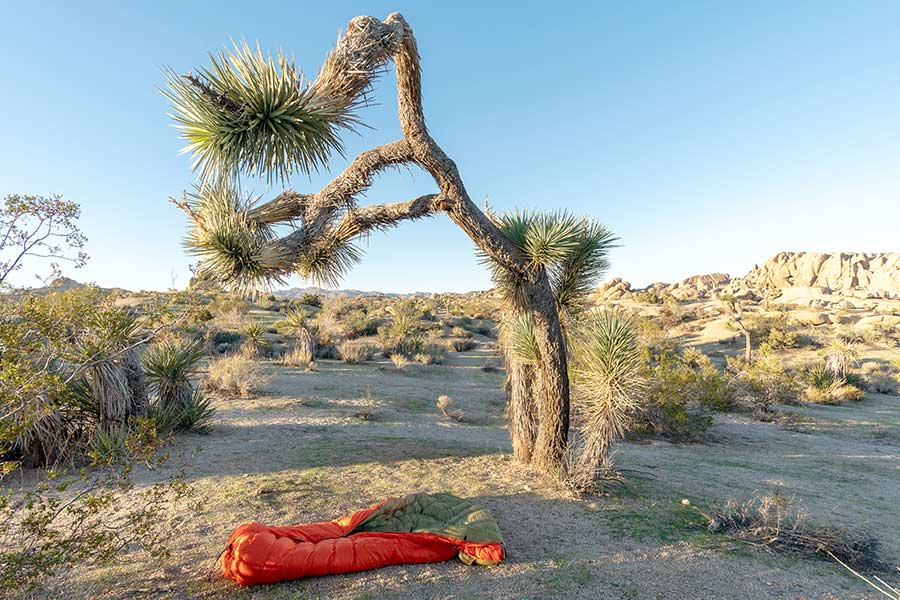
Pros and cons of each type of insulation
Down and synthetic are two types of insulation commonly found in sleeping bags. Each offer advantages and drawbacks, so it’s necessary to understand the pros and cons before choosing a sleeping bag for your camping needs.
Down:
- Pros: Lightweight, highly compressible, offers excellent warmth in cold temperatures
- Cons: Expensive, not as durable as synthetic materials, and does not do well when wet
Synthetic:
- Pros: Affordable, durable, and works better when wet
- Cons: Heavier than down, doesn’t provide as much warmth, and is not as compressible
Selecting the right insulation type for your camping needs and preferences depends on a few key factors.
First, consider the climate you will be camping in. If it’s cold, then look for a down sleeping bag, as they offer excellent warmth even in frigid temperatures. Alternatively, synthetic materials are better suited when there is rain or snow since they are more resistant to moisture.
Next, think about your budget. Down sleeping bags tend to be more expensive than synthetic ones but are usually well worth the extra cost if you need maximum warmth. On the other hand, synthetic materials are cheaper and may be sufficient for mild climates and short trips.
Finally, consider your preference for weight and bulkiness. Down is much lighter and more compressible than synthetic materials, so if you’re looking for a lightweight sleeping bag, then down may be the way to go. On the other hand, synthetic materials are bulkier, so they might not be as easy to transport.
Ultimately, selecting the right insulation type for camping comes down to understanding your needs and preferences and choosing accordingly.
Van Camping Life Tip: Camping with blankets is an option if you don’t camp often and don’t want to invest in sleeping bags.
Other Posts of Interest
- How Many Sleeping Bags Do You Actually Need?
- Do Any Vans Have 4-Wheel Drive?
- What Is A Pie Iron?
- Are Otzi Flat Pack Grills Worth the Money?
Shape and Size
Sleeping bags come in various shapes and sizes designed for different camping needs and preferences.
Mummy sleeping bags are the most popular as they are designed to keep your body warm by gently wrapping around you like a cocoon. This style is great for colder climates and those looking to stay snug while camping. Mummy bags typically come with hoods to keep heat in, and they have foot boxes that let you move your feet inside the bag.
Rectangular sleeping bags, sometimes called “blanket” sleeping bags, on the other hand, offer more room to move and are often used when camping in milder climates or staying indoors. They also provide extra comfort due to their wider cut, which makes them ideal for family camping trips.
There are also semi-rectangular bags which are a combination of mummy and rectangular styles, offering extra warmth while still allowing enough space for movement. These are great for varied conditions that might require additional warmth but still require some freedom to move around.
When selecting a sleeping bag, it’s paramount to consider the shape and size that best suits your individual needs and preferences.
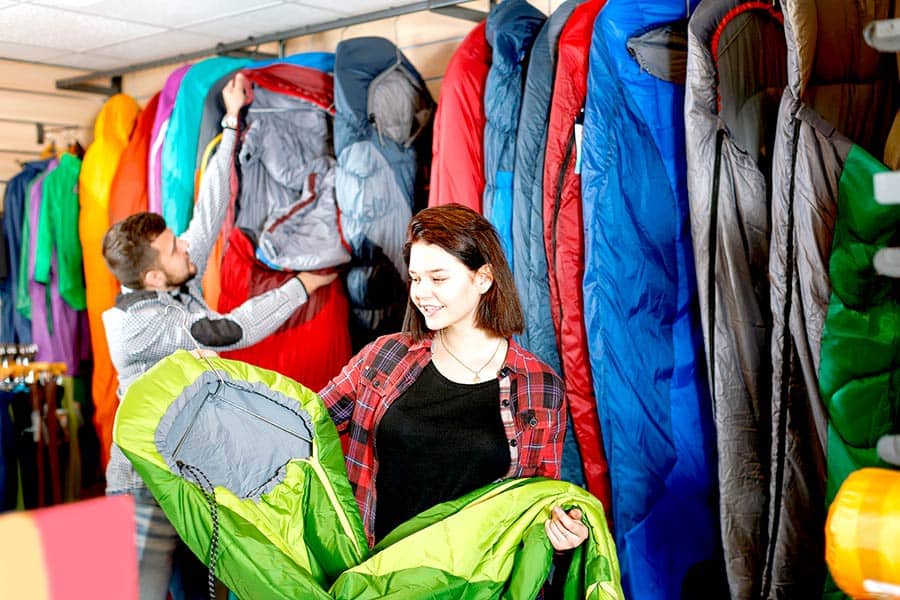
Pros and cons of each shape and size
Mummy sleeping bags provide the maximum warmth and are designed to fit snuggly around your body, but they can feel restrictive and may be too cozy for some. They also tend to be more expensive than other shapes.
Rectangular sleeping bags offer extra room to move around, as well as more comfort, making them great for milder climates or family camping trips. However, they provide less insulation than mummy styles and tend to be bulkier, so they’re not ideal for colder climates or extended trips.
Semi-rectangular sleeping bags combine warmth and mobility and are suited to varied conditions. The downside is that these styles cost more and may not provide enough warmth if you’re camping in frigid climates or going on an extended trip.
Before buying a sleeping bag, determine what type of climate you will be camping in and whether you need the maximum insulation or extra room to move around.
If you’re planning on camping in cold temperatures or going on an extended trip, make sure that the sleeping bag you choose is able to keep you warm. Consider factors such as size and shape when choosing – it should fit comfortably without being too restrictive or bulky.
Additional Features
When selecting a sleeping bag, there are some additional features that can make your camping experience more comfortable.
A hood lets you keep your head and neck warm while providing additional insulation against cold temperatures. Zippers help you to easily adjust the fit of the sleeping bag according to your needs, while a draft tube prevents cold air from entering through the zipper.
It is also worth considering whether or not the sleeping bag has compressible insulation – this will help keep it lightweight and easy to carry. Additionally, waterproofing will protect the material from dampness or moisture.
Pros and cons of these features
There are pros and cons to consider when looking at the features of a sleeping bag.
- A hood is great for keeping your head and neck warm but adds weight to the bag.
- Zippers can be helpful in adjusting the fit, but if not correctly sealed, they can allow cold air to enter.
- Draft tubes are beneficial for blocking cold air but may cause discomfort if too tight.
- Compressible insulation increases warmth while decreasing weight, but it can also be more expensive than non-compressible alternatives.
- Lastly, waterproofing helps keep the material dry but adds additional cost.
By considering these features carefully and weighing the advantages and disadvantages, you will be able to find a sleeping bag that meets your needs and preferences.
Cost of Sleeping Bags for Camping
When it comes to pricing, there are a few things to keep in mind. Generally speaking, the more features and higher level of quality a sleeping bag offers, the more expensive it’s likely to be.
Temperature rating is also an important factor—down sleeping bags tend to be more expensive than synthetic ones, but they offer a higher level of warmth and comfort.
In general, you can expect to pay anywhere from $50-$200+ for a sleeping bag depending on the features and quality you’re looking for.
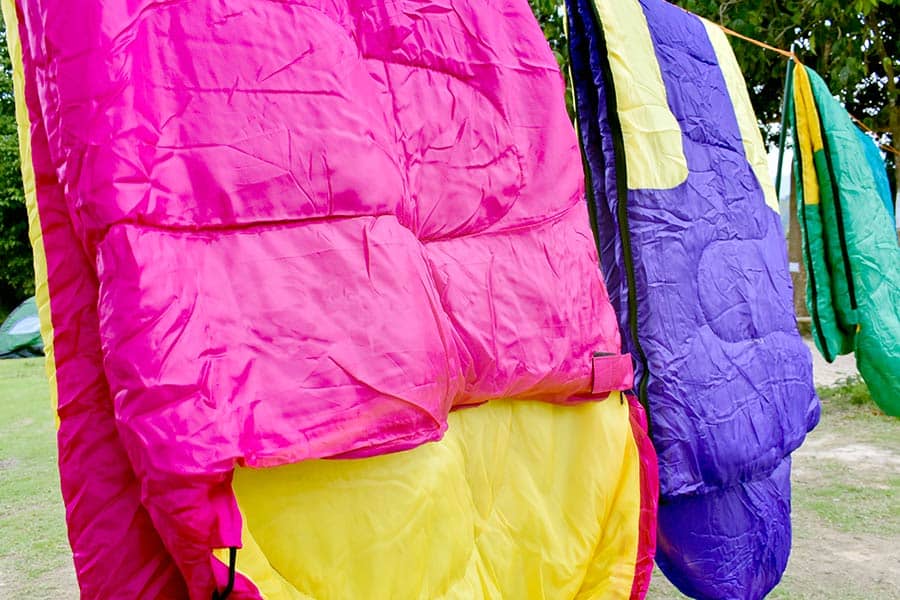
Care and Maintenance
It is essential to take proper care and maintenance measures to ensure optimal performance and maximize the lifespan of your sleeping bag.
- Store the sleeping bag in a cool, dry location and make sure it has plenty of space so it does not get compressed or bunched up.
- If possible, hang or loosely stuff the sleeping bag instead of rolling or folding it into small sections.
- After each use, it’s important to air out the bag to remove moisture and odors.
- Wash as needed using gentle detergents on cold settings, and avoid using any fabric softeners.
- Inspect your sleeping bag periodically for signs of wear and tear, such as rips or loose stitching so that you can repair them promptly.
Proper storage and cleaning of your sleeping bag are vital to ensure maximum lifespan and performance.
Snug as a Bug
In conclusion, choosing the right camping sleeping bag is essential to a comfortable and enjoyable experience. Temperature rating, insulation type, shape and size, and additional features are all important considerations when selecting a sleeping bag.
It is also necessary to properly care for and maintain your sleeping bag to keep it in top condition. By understanding the major factors involved in selecting a sleeping bag for camping, you can make sure that you find one that meets all of your needs and preferences.





